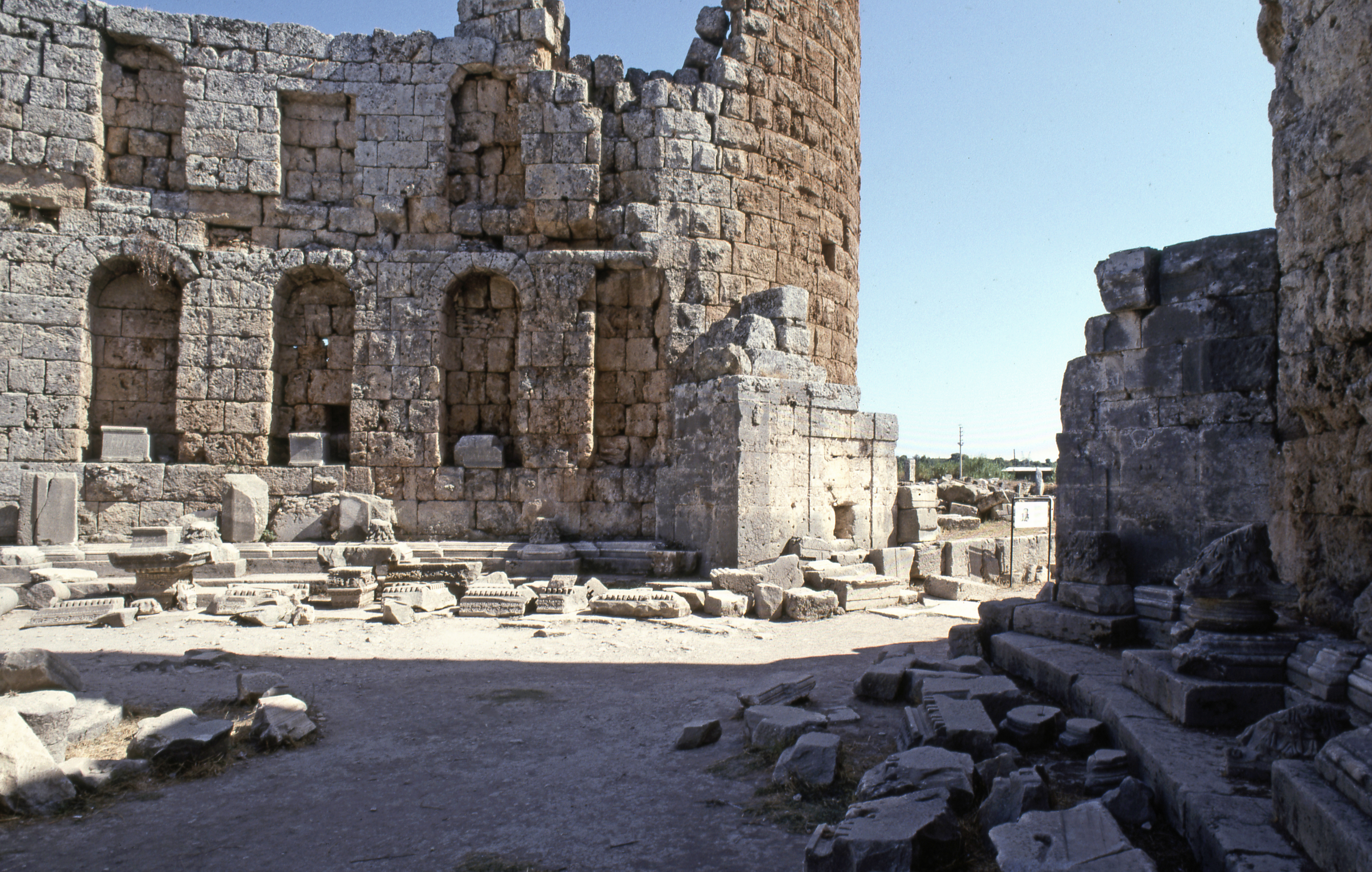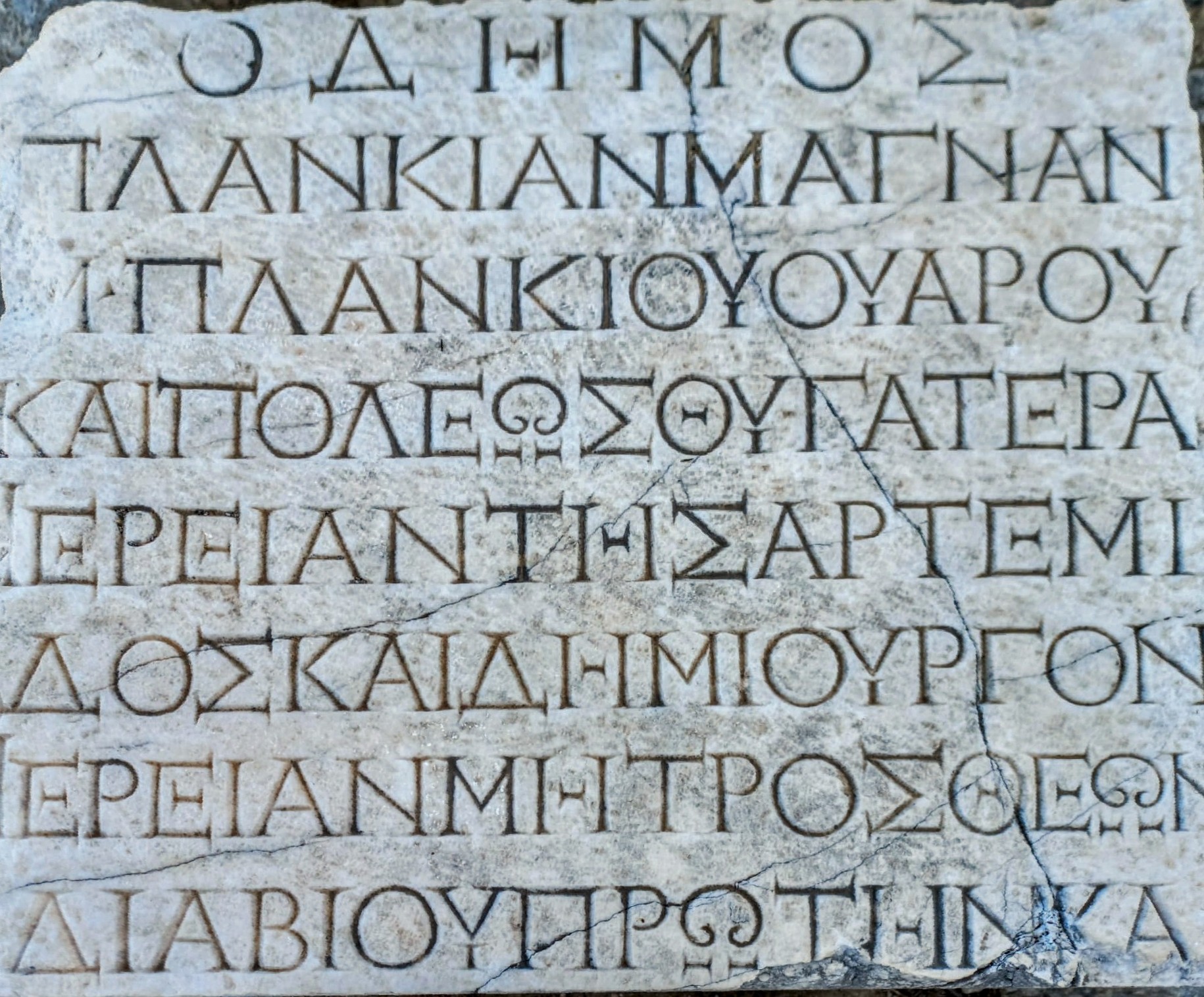Plancia Magna on:
[Wikipedia]
[Google]
[Amazon]
Plancia Magna () was a prominent woman of
 In the reign of
In the reign of  A surviving inscription from the base of a statue erected by the community of Perga reveals her position in the city:
:Plancia Magna
:Daughter of Marcus Plancius Varus
:and daughter of the city.
:Priestess of Artemis
:and both first and sole public priestess
:of the mother of the gods
:for the duration of her life
:pious and patriotic.
A surviving inscription from the base of a statue erected by the community of Perga reveals her position in the city:
:Plancia Magna
:Daughter of Marcus Plancius Varus
:and daughter of the city.
:Priestess of Artemis
:and both first and sole public priestess
:of the mother of the gods
:for the duration of her life
:pious and patriotic.
Plancia Magna, Aurelia Paulina, and Regilla: Civic Donors
(last visited 24 March 2017)
Plancia Magna Inscription (AE 1965, 210 = IK-54 90)Statue of Plancia Magna
(photo)
Statue of Plancia Magna
(photo) {{DEFAULTSORT:Plancia Magna 1st-century Romans 2nd-century Romans 1st-century Roman women 2nd-century Roman women Priestesses from the Roman Empire 1st-century clergy 2nd-century clergy Herodian dynasty People from Roman Anatolia Plancii
Perga
Perga or Perge ( Hittite: ''Parha'', ''Perge'', ) was originally an ancient Lycian settlement that later became a Greek city in Pamphylia. It was the capital of the Roman province of Pamphylia Secunda, now located in Antalya Province on the ...
in the Roman
Roman or Romans most often refers to:
*Rome, the capital city of Italy
*Ancient Rome, Roman civilization from 8th century BC to 5th century AD
*Roman people, the people of Roman civilization
*Epistle to the Romans, shortened to Romans, a letter w ...
province of Lycia et Pamphylia
Lycia and Pamphylia (; ) was the name of a province of the Roman Empire, located in southern Anatolia. It was created by the emperor Vespasian (69–79), who merged Lycia and Pamphylia into a single administrative unit. In 43 AD, the emperor Cl ...
who lived in the 1st and 2nd centuries. During her life she was not only a high priestess, but a decurion and preeminent benefactress to the city, funding the restoration of the main city gates between the years AD 119 and 122.
Ancestry, family, and early life
Plancia Magna was the daughter of theRoman Senator
The Roman Senate () was the highest and Roman constitution, constituting assembly of ancient Rome and its aristocracy. With different powers throughout its existence it lasted from the first days of the Rome, city of Rome (traditionally founded ...
Marcus Plancius Varus
Marcus Plancius Varus was an Anatolian Roman noble who lived in the 1st century in the Roman Empire. His paternal ancestors were originally from Latium in Central Italy. They had immigrated to Anatolia in the time of the late Roman Republic. Varus ...
and the Herodian Princess Julia
Julia may refer to:
People
*Julia (given name), including a list of people with the name
*Julia (surname), including a list of people with the name
*Julia gens, a patrician family of Ancient Rome
*Julia (clairvoyant) (fl. 1689), lady's maid of Qu ...
, daughter of king Tigranes VI of Armenia
Tigranes VI, also known as Tigran VI or by his Roman name Gaius Julius Tigranes (, before 25 – after 68) was a Herodian prince and served as a Roman client king of Armenia in the 1st century.
He was the child born to Alexander by an unnamed ...
. The Plancii were among the wealthiest and most notable families of Roman Asia Minor
Anatolia (), also known as Asia Minor, is a peninsula in West Asia that makes up the majority of the land area of Turkey. It is the westernmost protrusion of Asia and is geographically bounded by the Mediterranean Sea to the south, the Aegean ...
around this time, having arrived in Perga as traders from Latium
Latium ( , ; ) is the region of central western Italy in which the city of Rome was founded and grew to be the capital city of the Roman Empire.
Definition
Latium was originally a small triangle of fertile, volcanic soil (Old Latium) on whic ...
at the end of the Roman Republic
The Roman Republic ( ) was the era of Ancient Rome, classical Roman civilisation beginning with Overthrow of the Roman monarchy, the overthrow of the Roman Kingdom (traditionally dated to 509 BC) and ending in 27 BC with the establis ...
. Both Magna's father and her brother, Gaius Plancius Varus
Gaius Plancius Varus was a Roman who lived between the 1st century and 2nd century in the Roman Empire. Varus was the son of the Roman Senator and Proconsul Marcus Plancius Varus, and the Herodian Princess Julia. His sister was Plancia Magna; ...
, were given the honorary title ''ktistes'' ("founder"), reflecting their local prominence and patronage of the city.
Magna married the Roman Senator Gaius Julius Cornutus Tertullus
Gaius Julius Cornutus Tertullus was a Roman senator who was active during the late 1st and early 2nd centuries. He is best known as the older friend of Pliny the Younger, with whom Cornutus was suffect consul for the '' nundinium'' of September to ...
, suffect consul
The consuls were the highest elected public officials of the Roman Republic ( to 27 BC). Romans considered the consulship the second-highest level of the ''cursus honorum''an ascending sequence of public offices to which politicians aspire ...
in 100 with his friend Pliny the Younger
Gaius Plinius Caecilius Secundus (born Gaius Caecilius or Gaius Caecilius Cilo; 61 – ), better known in English as Pliny the Younger ( ), was a lawyer, author, and magistrate of Ancient Rome. Pliny's uncle, Pliny the Elder, helped raise and e ...
. Magna bore Tertullus a son, Gaius Julius Plancius Varus Cornutus
Gaius Julius Plancius Varus Cornutus was a man of Roman Senate, Roman Senatorial rank who lived in the Roman Empire in the 2nd century.
Cornutus was the son of Gaius Julius Cornutus Tertullus and Plancia Magna. His paternal grandparents were the P ...
.
Activity in Perga
 In the reign of
In the reign of Emperor Hadrian
Hadrian ( ; ; 24 January 76 – 10 July 138) was Roman emperor from 117 to 138. Hadrian was born in Italica, close to modern Seville in Spain, an Italic peoples, Italic settlement in Hispania Baetica; his branch of the Aelia gens, Aelia '' ...
, Plancia Magna funded major civic improvements in Perga. These improvements included the restoration and expansion of the Hellenistic southern gate at Perga, a magnificent structure protecting the coast-facing entrance to the city, originally built in the 3rd century BC. The round towers flanking the gate were refurbished, and just past the gate was constructed a horseshoe-shaped courtyard adorned with two tiers of statues, twenty-eight in total. On the lower tier were large statues of various Greek deities, while the upper tier held smaller depictions of historical and mythological figures linked to Perga, including Magna's own father and brother. Adjacent niches, their contents now lost, may have contained statues of Magna's husband or son, also prominent local figures. Uniquely, the inscriptions define Magna's family members in relation to her ("father/brother of Plancia Magna"), establishing a dominance which is unseen in other contemporary female-commissioned statuary.
The exit from the courtyard into the city was through a monumental triple passage arch, which housed further statues of Artemis
In ancient Greek religion and Greek mythology, mythology, Artemis (; ) is the goddess of the hunting, hunt, the wilderness, wild animals, transitions, nature, vegetation, childbirth, Kourotrophos, care of children, and chastity. In later tim ...
(Perga's chief deity) and the deified
Apotheosis (, ), also called divinization or deification (), is the glorification of a subject to divine levels and, commonly, the treatment of a human being, any other living thing, or an abstract idea in the likeness of a deity.
The origina ...
imperial family. The assemblage included more imperial women than men. The inscription for Salonia Matidia
Salonia Matidia (4 July 68 – 23 December 119) was the daughter and only child of Ulpia Marciana and wealthy praetor Gaius Salonius Matidius Patruinus. Her maternal uncle was the Roman emperor Trajan. Trajan had no children and treated her lik ...
(died 119) uses the posthumous title ''diva'', while that of Pompeia Plotina
Pompeia Plotina (died 121/122) was Roman empress from 98 to 117 as the wife of Trajan. She was renowned for her interest in philosophy, and her virtue, dignity and simplicity. She was particularly devoted to the Epicurean philosophical school in ...
(died 122) does not—thus, the erection of the statues can be approximately dated to within the intervening years. Each statue's inscription included an attribution, identifying them as the product of Magna's beneficence:
Translated from Latin
Latin ( or ) is a classical language belonging to the Italic languages, Italic branch of the Indo-European languages. Latin was originally spoken by the Latins (Italic tribe), Latins in Latium (now known as Lazio), the lower Tiber area aroun ...
irst two lines
:to the genius of the city
:Plancia Magna daughter of Marcus
Translated from Greek ast two lines
:to the fortune of the city
:Plancia Magna
In addition to her donations, Magna was personally active in the civil and religious society of Perga. She served multiple terms as city magistrate, and held a wealth of titles: priestess of Artemis, high-priestess of the imperial cult, "priestess for life of the mother of the gods", and ''demiourgos''. The last was the highest civil position attainable in the city, and the officeholder's name was used to identify the year in all official documents. Magna is the only known female ''demiourgos'' of Perga.
 A surviving inscription from the base of a statue erected by the community of Perga reveals her position in the city:
:Plancia Magna
:Daughter of Marcus Plancius Varus
:and daughter of the city.
:Priestess of Artemis
:and both first and sole public priestess
:of the mother of the gods
:for the duration of her life
:pious and patriotic.
A surviving inscription from the base of a statue erected by the community of Perga reveals her position in the city:
:Plancia Magna
:Daughter of Marcus Plancius Varus
:and daughter of the city.
:Priestess of Artemis
:and both first and sole public priestess
:of the mother of the gods
:for the duration of her life
:pious and patriotic.
References
Further reading
* Sheila Dillon (2010). ''The Female Portrait Statue in the Greek World''. Cambridge University Press, pp. 155–161. *Elaine Fantham
Elaine Fantham (born Elaine Crosthwaite, 25 May 1933 – 11 July 2016) was a British-Canadian classicist whose expertise lay particularly in Latin literature, especially comedy, epic poetry and rhetoric, and in the social history of Roman women. ...
, Helene Peet Foley, Natalie Boymel Kampen, Sarah B. Pomeroy & H. Alan Shapiro (1995). ''Women in the Classical World: Image and Text'', Oxford University Press, pp. 363, 364f.
* Charles Gates (2003). ''Ancient Cities: the Archaeology of Urban Life in the Ancient Near East and Egypt, Greece and Rome'', Routledge.
External links
Plancia Magna, Aurelia Paulina, and Regilla: Civic Donors
(last visited 24 March 2017)
(photo)
Statue of Plancia Magna
(photo) {{DEFAULTSORT:Plancia Magna 1st-century Romans 2nd-century Romans 1st-century Roman women 2nd-century Roman women Priestesses from the Roman Empire 1st-century clergy 2nd-century clergy Herodian dynasty People from Roman Anatolia Plancii